ESTABLISHMENTS WITH PREVENTIVE AND CONTROL MEASURES AGAINST SAFETY AND HEALTH HAZARDS
- Of the total establishments employing 20 or more workers covered in 2019, 98.6 percent had conducted several preventive and control measures to protect workers and prevent unnecessary hazards in their workplace. This was a minimal increase of 0.5 percentage point from the data recorded in 2017 (98.1%). (Figure 1)
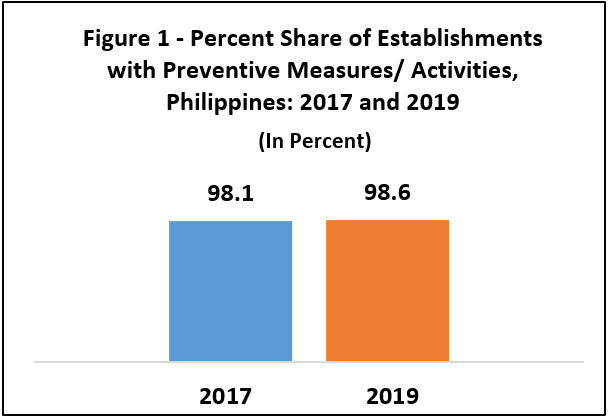
- By industry, wholesale and retail trade; repair of motor vehicles and motorcycles posted the biggest share in terms of the number of establishments conducting preventive measures at 24.8 percent, followed by manufacturing (16.8%) and accommodation and food service activities (12.5%). (Figure 2)
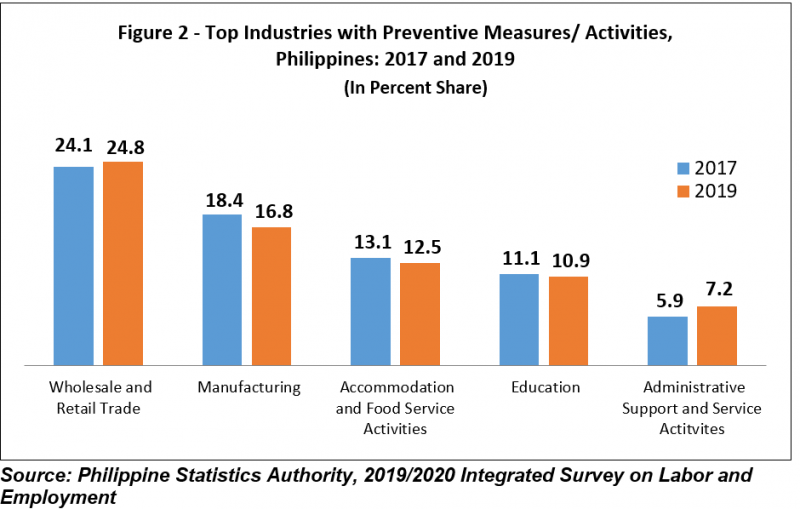
TOP 5 PREVENTIVE AND CONTROL MEASURES/ACTIVITIES CONDUCTED AGAINST WORK SAFETY AND HEALTH HAZARDS
- Generally, posting of safety signage or warnings was the most common activity conducted among establishments at 89.7 percent. This was followed by dissemination of information materials on safety and health at 83.9 percent. (Table 1)
- Other top measures/activities usually conducted were: regular inspection and conduct of maintenance of equipment, mechanical and electrical facilities (83.2%); conduct of emergency response preparedness activities for earthquake, fire, chemical spills, etc. (82.4%); and organizing safety and health committee (82.0).
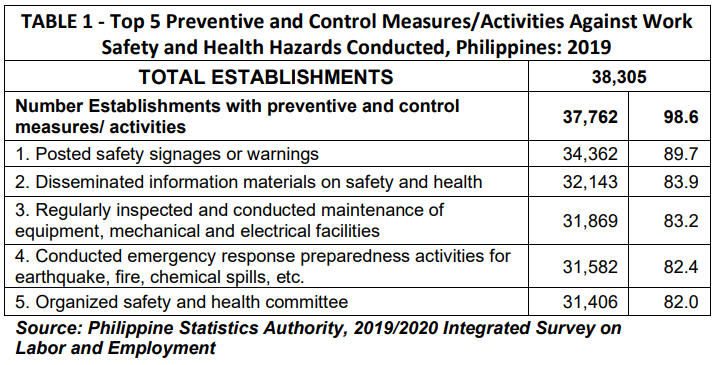
TOP 5 OCCUPATIONAL SAFETY AND HEALTH POLICIES/PROGRAMS IMPLEMENTED
- To ensure occupational safety and good health conditions among the employees, almost all or 95.8 percent of the total establishments had implemented various occupational safety and health (OSH) policies/programs in 2019. (Table 2)
- Policy on smoke-free workplace and fire prevention and control program were the topmost OSH policies/programs implemented at 85.3 and 83.6 percent, respectively.
- Other top OSH policies/programs include policy and program on anti-sexual harassment (77.7%); emergency preparedness and response program (74.0%); and work accident prevention program (72.3%).
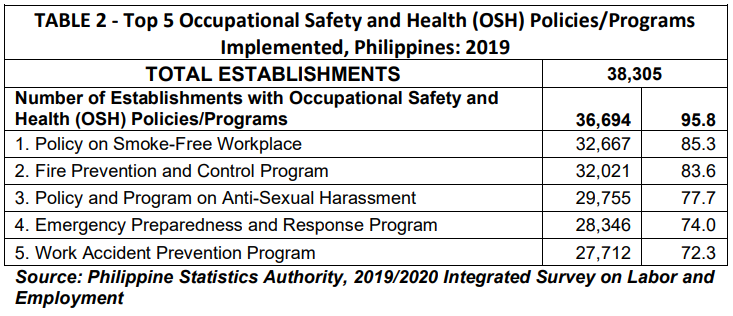
OCCUPATIONAL SAFETY AND HEALTH–RELATED TRAININGS/SEMINARS
- During the reference year, 85.8 percent of the total establishments had conducted various OSH-related trainings/seminars. The most common among the trainings/seminars were first aid training and fire safety training which accounted for about three in every five establishments (61.5% and 60.9%, respectively). (Figure 3)
- Other OSH-related trainings/seminars commonly availed by employees were: 40-Hour basic occupational safety and health training for Safety Officer 2 (44.9%); emergency preparedness and response (32.2%); and drug-free workplace training (27.4%).
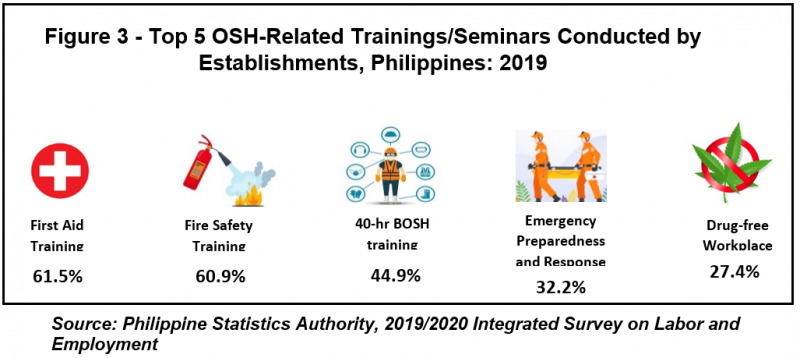
- More than half of the recorded OSH-related trainings/seminars were conducted by the Bureau of Fire Protection (BFP) and by the company itself at 57.7 and 54.1 percent, respectively. Meanwhile, 43.6 percent of the OSH trainings/seminars were also conducted by the Philippine Red Cross; and by the Occupational Safety and Health Center/OSHNet at 33.7 percent. (Figure 4)
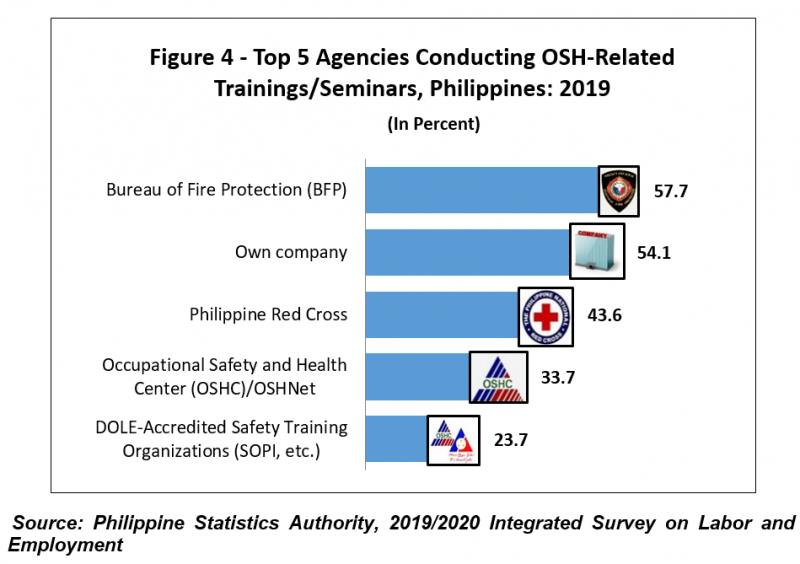
ESTABLISHMENTS WITH DESIGNATED HEALTH AND SAFETY PERSONNEL
- Designation of health and safety officers in establishments for the implementation of their OSH preventive/control measures and OSH policies and programs is one of the requirements under the Republic Act 11058 or the OSH Law. Out of the total establishments in 2019, 81.7 percent or about four in every five establishments have designated safety and health personnel.
- By industry group, the highest share of establishments with designated health and safety personnel was accounted in wholesale and retail trade at 23.9 percent, followed by manufacturing at 17.6 percent and accommodation and food service activities at 12.9 percent. (Figure 5)
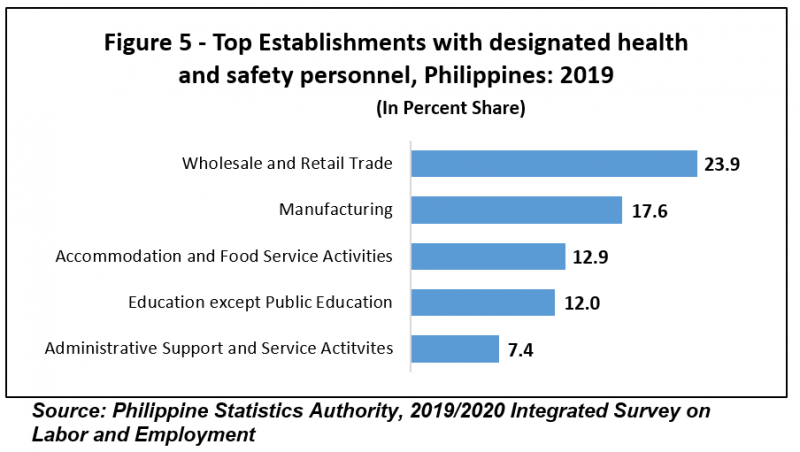
- Meanwhile, trained first-aiders were the most common designated health and safety personnel among establishments with 58.6 percent. This was followed by accredited Safety Officer 1, or those who has completed the mandatory 8-hour OSH training, with 37.6 percent and occupational health nurses with 24.8 percent. (Figure 6)
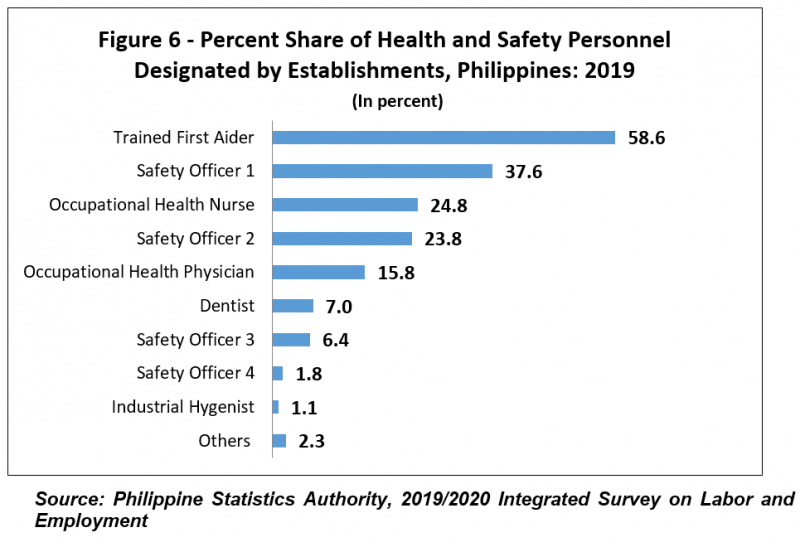
DENNIS S. MAPA, Ph.D.
Undersecretary
National Statistician and Civil Registrar General
See more at the Integrated Survey on Labor and Employment Landing Page.
Survey Information:
This module on Occupational Safety and Health Practices (OSHP) is a rider survey from the Occupational Safety and Health Center (OSHC), an attached agency of the Department of Labor and Employment (DOLE). This module gathers information on the (1) prevention and control measures/activities against work safety and health conducted by establishments; (2) occupational safety and health policies/programs implemented in establishments; (3) occupational safety and health-related trainings/seminars availed by employees in establishments; (4) top three (3) training agencies/organizations that conduct safety and health-related trainings/seminars to employees in establishments; and (5) types of designated health and safety personnel in establishments.
The result of this survey module on OSH Practices will serve as significant contribution to government policymakers to assess compliance of establishments to mandatory trainings and workplace standards to ensure safety and health at the worksites. Another objective of this survey is to give additional information on workplace standards in establishments to augment labor standards statistics generated by administrative reports and compliance reports based on inspections conducted to establishments.
Likewise, data generated on safety and health-related trainings/seminars availed by employees in establishments will provide the government with the needed inputs on what training programs need to be further advocated, developed and implemented to further upgrade the competence of personnel in the field of occupational safety and industrial health. Statistics generated from this module is also one of the main sources of presentation materials in the regular conduct of the National Occupational Safety and Health (NOSH) Congress attended by OSH champions from private and government offices nationwide.
DEFINITION OF TERMS:
Basic Occupational Safety and Health Training (BOSH) – one of the mandatory 40-hour training courses required for Safety Officers under Rule 1030 of the Occupational Safety and Health Standards (OSHS). It aims to equip participants with the basic knowledge and skills on identifying safety, health and environmental hazards; determining appropriate control measures; and developing and implementing OSH policies and programs.
Construction Safety and Health Training (COSH) – one of the mandatory 40-hour training courses required for Safety Officers working in the construction industry under Rule 1030 of the Occupational Safety and Health Standards (OSHS) and the DOLE Department Order No. 13, s. 1998: Guidelines Governing Safety and Health in the Construction Industry. This training aims to equip participants with the basic knowledge and skills in performing safety audits, assessments and analysis of hazards and risks in the construction industry; determining appropriate control measures; and developing and implementing OSH policies and programs.
Chemical Safety Training – is a training designed to provide participants with knowledge on the various aspects of managing and promoting chemical safety and develop their capability in implementing solution-oriented approaches on the safe use of chemicals. Discussions focus on: the Globally Harmonized System of Classification and Labeling of Chemicals; storage and handling, health effects of chemicals; fire and explosion; waste management; operational control; emergency procedures; and management of chemical control program.
Ergonomics Training – is a course that aims to enable participants to assess ergonomic risk factors in the workplace and to apply basic ergonomic principles to manage identified risks and prevent occupational injuries.
Personal Protective Equipment – refers to a specialized clothing or equipment designed to protect workers against safety and health hazards that may cause serious workplace injuries and illnesses. i.e., goggles, helmet, masks, safety gloves, safety shoes, earmuffs, etc.
Risk-Based Programs - OSH programs that will reduce the risk of accident, injury, or illness due to exposure to specific hazards.
Safety Officer - refers to any employee/worker trained and tasked to implement occupational safety and health programs in the workplace in accordance with the provisions of the OSHS.
Safety Officer 1 (SO1) - refers to an employee who has completed the mandatory eight (8)-hour OSH orientation course as prescribed in the OSH Standards and two (2)-hour trainers' training.
Safety Officer 2 (SO2) - refers to an employee who has completed the mandatory forty (40)-hour OSH training course applicable to the industry as prescribed in the OSH Standards.
Safety Officer 3 (SO3) - refers to an employee who has completed the mandatory forty (40)-hour OSH training course applicable to the industry, additional forty-eight (48) hours of advanced/specialized occupational safety training course relevant to the industry, relevant experience in OSH for at least two (2) years, and other requirements as prescribed in the OSH Standards. Qualified SO3 shall be eligible for certification as OSH practitioner.
Safety Officer 4 (SO4) - refers to an employee who has completed the mandatory forty (40)-hour OSH training course applicable to the industry, additional eighty (80) hours of advanced/specialized occupational safety training course relevant to the industry, an aggregate of three hundred twenty (320) hours of OSH related training or experience, an actual experience as SO3 for at least four (4) years, and other requirements as prescribed by the OSH standards. Additional training may be converted to years of experience where eighty (80) hours of training may equal to one (1) year of experience and vice versa. Qualified SO4 shall be eligible for certification as OSH consultant.
